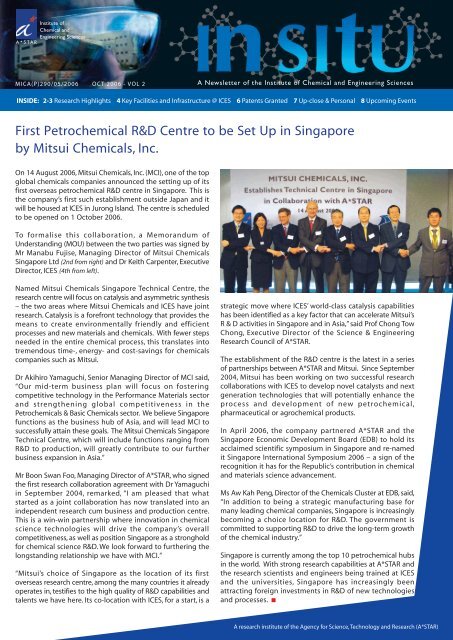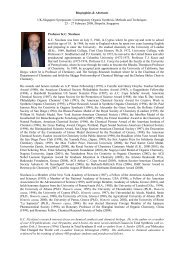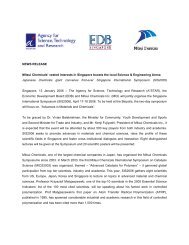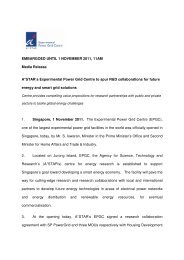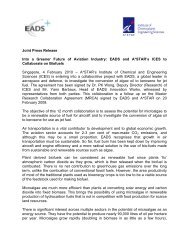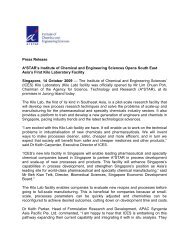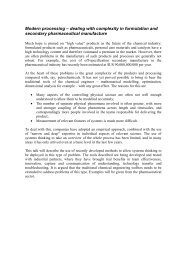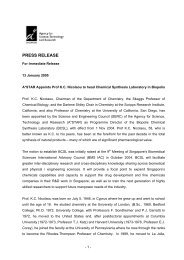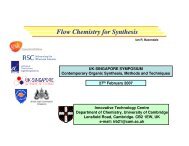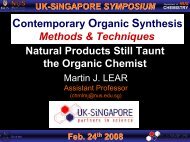INSITU Oct 2006 - Vol 2 - Institute of Chemical & Engineering ...
INSITU Oct 2006 - Vol 2 - Institute of Chemical & Engineering ...
INSITU Oct 2006 - Vol 2 - Institute of Chemical & Engineering ...
Create successful ePaper yourself
Turn your PDF publications into a flip-book with our unique Google optimized e-Paper software.
MICA(P)290/05/<strong>2006</strong> OCT <strong>2006</strong> - VOL 2<br />
A Newsletter <strong>of</strong> the <strong>Institute</strong> <strong>of</strong> <strong>Chemical</strong> and <strong>Engineering</strong> Sciences<br />
INSIDE: 2-3 Research Highlights 4 Key Facilities and Infrastructure @ ICES 6 Patents Granted 7 Up-close & Personal 8 Upcoming Events<br />
First Petrochemical R&D Centre to be Set Up in Singapore<br />
by Mitsui <strong>Chemical</strong>s, Inc.<br />
On 14 August <strong>2006</strong>, Mitsui <strong>Chemical</strong>s, Inc. (MCI), one <strong>of</strong> the top<br />
global chemicals companies announced the setting up <strong>of</strong> its<br />
first overseas petrochemical R&D centre in Singapore. This is<br />
the company’s first such establishment outside Japan and it<br />
will be housed at ICES in Jurong Island. The centre is scheduled<br />
to be opened on 1 <strong>Oct</strong>ober <strong>2006</strong>.<br />
To formalise this collaboration, a Memorandum <strong>of</strong><br />
Understanding (MOU) between the two parties was signed by<br />
Mr Manabu Fujise, Managing Director <strong>of</strong> Mitsui <strong>Chemical</strong>s<br />
Singapore Ltd (2nd from right) and Dr Keith Carpenter, Executive<br />
Director, ICES (4th from left).<br />
Named Mitsui <strong>Chemical</strong>s Singapore Technical Centre, the<br />
research centre will focus on catalysis and asymmetric synthesis<br />
– the two areas where Mitsui <strong>Chemical</strong>s and ICES have joint<br />
research. Catalysis is a forefront technology that provides the<br />
means to create environmentally friendly and efficient<br />
processes and new materials and chemicals. With fewer steps<br />
needed in the entire chemical process, this translates into<br />
tremendous time-, energy- and cost-savings for chemicals<br />
companies such as Mitsui.<br />
Dr Akihiro Yamaguchi, Senior Managing Director <strong>of</strong> MCI said,<br />
“Our mid-term business plan will focus on fostering<br />
competitive technology in the Performance Materials sector<br />
and strengthening global competitiveness in the<br />
Petrochemicals & Basic <strong>Chemical</strong>s sector. We believe Singapore<br />
functions as the business hub <strong>of</strong> Asia, and will lead MCI to<br />
successfully attain these goals. The Mitsui <strong>Chemical</strong>s Singapore<br />
Technical Centre, which will include functions ranging from<br />
R&D to production, will greatly contribute to our further<br />
business expansion in Asia.”<br />
Mr Boon Swan Foo, Managing Director <strong>of</strong> A*STAR, who signed<br />
the first research collaboration agreement with Dr Yamaguchi<br />
in September 2004, remarked, “I am pleased that what<br />
started as a joint collaboration has now translated into an<br />
independent research cum business and production centre.<br />
This is a win-win partnership where innovation in chemical<br />
science technologies will drive the company’s overall<br />
competitiveness, as well as position Singapore as a stronghold<br />
for chemical science R&D. We look forward to furthering the<br />
longstanding relationship we have with MCI.”<br />
“Mitsui’s choice <strong>of</strong> Singapore as the location <strong>of</strong> its first<br />
overseas research centre, among the many countries it already<br />
operates in, testifies to the high quality <strong>of</strong> R&D capabilities and<br />
talents we have here. Its co-location with ICES, for a start, is a<br />
strategic move where ICES’ world-class catalysis capabilities<br />
has been identified as a key factor that can accelerate Mitsui’s<br />
R & D activities in Singapore and in Asia,” said Pr<strong>of</strong> Chong Tow<br />
Chong, Executive Director <strong>of</strong> the Science & <strong>Engineering</strong><br />
Research Council <strong>of</strong> A*STAR.<br />
The establishment <strong>of</strong> the R&D centre is the latest in a series<br />
<strong>of</strong> partnerships between A*STAR and Mitsui. Since September<br />
2004, Mitsui has been working on two successful research<br />
collaborations with ICES to develop novel catalysts and next<br />
generation technologies that will potentially enhance the<br />
process and development <strong>of</strong> new petrochemical,<br />
pharmaceutical or agrochemical products.<br />
In April <strong>2006</strong>, the company partnered A*STAR and the<br />
Singapore Economic Development Board (EDB) to hold its<br />
acclaimed scientific symposium in Singapore and re-named<br />
it Singapore International Symposium <strong>2006</strong> – a sign <strong>of</strong> the<br />
recognition it has for the Republic’s contribution in chemical<br />
and materials science advancement.<br />
Ms Aw Kah Peng, Director <strong>of</strong> the <strong>Chemical</strong>s Cluster at EDB, said,<br />
“In addition to being a strategic manufacturing base for<br />
many leading chemical companies, Singapore is increasingly<br />
becoming a choice location for R&D. The government is<br />
committed to supporting R&D to drive the long-term growth<br />
<strong>of</strong> the chemical industry.”<br />
Singapore is currently among the top 10 petrochemical hubs<br />
in the world. With strong research capabilities at A*STAR and<br />
the research scientists and engineers being trained at ICES<br />
and the universities, Singapore has increasingly been<br />
attracting foreign investments in R&D <strong>of</strong> new technologies<br />
and processes.<br />
A research institute <strong>of</strong> the Agency for Science, Technology and Research (A*STAR)
Research Highlights<br />
Enzymatic Production <strong>of</strong> Biodiesel<br />
In the face <strong>of</strong> diminishing petroleum reserves and global<br />
concern over greenhouse gases, the search for an<br />
alternative fuel, which is both renewable and clean,<br />
gathers momentum. Biodiesel (fatty acid methyl ester,<br />
FAME), synthesised from animal fats or vegetable oils (eg.<br />
palm oil), is an ideal candidate, being biodegradable, nontoxic,<br />
and essentially free <strong>of</strong> sulfur and aromatics. Being<br />
derived from renewable sources means that this fuel has<br />
little net contribution to CO 2 in the atmosphere. In<br />
addition, one major advantage is that biodiesel can be<br />
mixed with petroleum diesel and used directly in existing<br />
diesel engines with few or no modifications.<br />
Beginning with fats or oils, a simple reaction with methanol<br />
is carried out using a catalyst. After removing the glycerol<br />
by-product, biodiesel is obtained. Commercially, a chemical<br />
route is used which employs sodium hydroxide as the<br />
catalyst. However, this process can only use fats/oils which<br />
are free <strong>of</strong> contaiminating fatty acids, and it is difficult to<br />
recover the glycerol for other uses. The high energy<br />
consumption is also a disadvantage.<br />
An alternative method is to use a biocatalyst eg., lipase<br />
(an enzyme). This alternative route to biodiesel is<br />
environmentally friendly and can be carried out under<br />
mild conditions. Free fatty acids contained in fats or oils<br />
do not present any problem as they can be<br />
simultaneously converted to biodiesel. The glycerol byproduct<br />
is also formed in its natural state and can thus<br />
be easily separated and recovered from the biodiesel,<br />
unlike the chemical route where glycerol is produced in<br />
the salt form. By using lipase, which is immobilised onto<br />
solid support, the catalyst can be easily recycled and<br />
reused. Another advantage is that high value substances<br />
such as vitamin E, present in quantities up to 800-1200<br />
ppm in fresh crude palm oil, can be retained and extracted<br />
through this mild process, whereas it is destroyed in the<br />
high-temperature chemical process. However, enzyme<br />
deactivation and high enzyme cost are major challenges<br />
for the development <strong>of</strong> an economically competitive<br />
biocatalytic process.<br />
H 2 C OOCR 1<br />
HC OOCR 2<br />
H 2 C OOCR 3<br />
+ CH 3 OH<br />
catalyst<br />
R 1 CO 2 CH 3<br />
R 3 CO 2 CH 3<br />
H 2 C OH<br />
R 2 CO 2 CH 3 + HC OH<br />
H 2 C OH<br />
triglyceride methanol biodiesel glycerol<br />
To overcome the deactivation <strong>of</strong> enzymes caused by<br />
methanol and glycerol in the biocatalytic route to biodiesel,<br />
our biocatalysis team has invented a two-phase reaction<br />
process which significantly improves the stability and<br />
productivity <strong>of</strong> enzyme. Within the phase where the<br />
enzyme catalysed reaction takes place, the levels <strong>of</strong><br />
methanol and glycerol can be regulated, thus avoiding<br />
enzyme poisoning by these two compounds. This process<br />
allows a commercial immobilised lipase to be reused up<br />
to 8 times with high yields and no significant loss in enzyme<br />
activity, a major improvement over current published data.<br />
Preliminary work at ICES has also been carried out on<br />
Vitamin E extraction, using commercial adsorbents to<br />
recover up to 40% <strong>of</strong> the Vitamin E in crude palm oil.<br />
Biodiesel Process Flow<br />
Crude Palm Oil<br />
Shaking with methanol<br />
at 180 rpm, 60 o C<br />
HPLC analysis <strong>of</strong> methyl esters<br />
Although biodiesel is advantageous over fossil diesel in<br />
many aspects, one drawback is its higher cloud point<br />
(temperature where the fuel becomes non-homogenous<br />
or cloudy, making it unsuitable for engine use), which makes<br />
it difficult to use in cold weather (below -5 o C). The existing<br />
method <strong>of</strong> overcoming this problem is to use additives. An<br />
alternative solution is the so-called second generation<br />
biodiesel, a mixture <strong>of</strong> parafin and isoparafin, produced by<br />
hydrolysis instead, followed by hydrogenation and<br />
isomerisation steps. ICES is now actively working on further<br />
improvement <strong>of</strong> the enzymatic process, recovery <strong>of</strong> saltfree<br />
glycerol, extraction <strong>of</strong> Vitamin E, and is considering the<br />
production <strong>of</strong> a second generation biodiesel.<br />
The list <strong>of</strong> relevant publications and patents is as follows:<br />
Separation <strong>of</strong> Biodiesel<br />
by centrifugation<br />
Biodiesel (methyl ester <strong>of</strong> fatty acids)<br />
1. Talukder MMR, Wu JC. A novel process for enzymatic production <strong>of</strong><br />
biodiesel by methanolysis <strong>of</strong> oils or fats. US provisional patent, filed<br />
on 14 November 2004.<br />
2. Talukder MMR, Puah SM, Wu JC, Choi WJ, Chow Y. Lipase-catalyzed<br />
methanolysis <strong>of</strong> palm oil in presence and absence <strong>of</strong> organic solvent<br />
for production <strong>of</strong> biodiesel. Biocatalysis & Biotransformation, <strong>2006</strong>, 24:<br />
in press.<br />
2
3<br />
Exploiting Novel Particle Technology for More Effective Inhaled Drug Delivery<br />
Inhaled dry powder aerosols are effective therapeutic<br />
carriers for target-specific treatments <strong>of</strong> various<br />
pulmonary diseases, such as asthma, cystic fibrosis,<br />
chronic pulmonary infections and lung cancer. Owing<br />
to the high permeability <strong>of</strong> the human lung’s epithelia<br />
towards therapeutic agents, inhaled dry powder aerosols<br />
can also serve as attractive alternatives to oral and<br />
parenteral routes for the systemic delivery <strong>of</strong> other<br />
therapeutic agents, such as insulin or growth hormone,<br />
that can only be delivered currently through the<br />
gastrointestinal tract or parenterally by either intravenous<br />
or intramuscular injections.<br />
Due to rapid advances in nanotechnology, the use <strong>of</strong><br />
nanoparticulate drugs as therapeutic carriers has become<br />
a subject <strong>of</strong> very active research. Nanoparticulate drugs<br />
have an enormous potential in significantly improving<br />
the systemic bioavailability <strong>of</strong> a drug, which is defined<br />
as the rate and extent <strong>of</strong> the therapeutically active drug<br />
that reaches systemic circulation. The high systemic<br />
bioavailability <strong>of</strong> nanoparticulate drugs is attributed to<br />
their higher dissolution rate in an aqueous environment,<br />
resulting from the larger surface areas compared to their<br />
micron-sized particle counterparts.<br />
As a result, a wide range <strong>of</strong> nanoparticulate drugs for oral<br />
and parenteral delivery, in the form <strong>of</strong> nanoparticulate<br />
suspensions and nanoparticulate composites, has been<br />
investigated, and several <strong>of</strong> them have already been<br />
commercially manufactured. However, much less<br />
attention has been paid to the dry powder aerosol<br />
delivery <strong>of</strong> nanoparticulate drugs. The current lack <strong>of</strong><br />
commercial appeal in dry powder aerosol delivery <strong>of</strong><br />
nanoparticulate drugs is attributed to the fact that: 1)<br />
nanoparticulate aerosols are predominantly exhaled and<br />
not deposited in the lungs due to their extremely low<br />
inertia, and 2) the persistent aggregation problem arising<br />
from their small size, which makes their physical handling<br />
extremely difficult for the dry powder inhaler (DPI)<br />
applications.<br />
To circumvent the above problems, the present work has<br />
involved the development <strong>of</strong> a novel formulation<br />
technique to manufacture micron-sized carrier particles<br />
designed to facilitate the delivery <strong>of</strong> nanoparticulate drugs<br />
via inhalation. Large hollow carrier particles (Figure 1),<br />
whose shells are composed <strong>of</strong> nanoparticulate aggregates<br />
(Figure 2) that can potentially be loaded with therapeutic<br />
agents, have been manufactured by employing a spray<br />
drying technique. The nanoparticulate aggregates are<br />
designed to disassociate into primary nanoparticles in<br />
the aqueous environment <strong>of</strong> the lungs, where the<br />
Figure 1.<br />
Large hollow<br />
nanoparticulate<br />
aggregates as<br />
carrier particles<br />
Figure 2.<br />
A close-up view <strong>of</strong><br />
the shell<br />
composed <strong>of</strong> the<br />
nanoparticulate<br />
aggregates<br />
therapeutic agents entrapped in the nanoparticles are<br />
released, and subsequently delivered to a specific<br />
pulmonary target, or into systemic circulation. The large<br />
hollow nanoparticulate aggregates have been<br />
manufactured using nanoparticles <strong>of</strong> differing chemical<br />
nature and size. Owing to their physical characteristics,<br />
the large hollow nanoparticulate aggregates possess two<br />
valuable attributes for use in a dry powder inhaler: 1) the<br />
large geometric size (d g 10µm) reduces their tendency<br />
to aggregate, which consequently improves the<br />
flowability <strong>of</strong> the carrier particles from the inhaler, and<br />
2) by virtue <strong>of</strong> their small aerodynamic diameters<br />
(d a 5µm) , the deposition <strong>of</strong> the carrier particles in the<br />
mouth and throat regions is minimised, so that they are<br />
capable <strong>of</strong> reaching the targeted alveolar region <strong>of</strong> the<br />
lungs more effectively.<br />
Reference<br />
Hadinoto K., Phanapavudhikul P., Zhu K.W and Tan R.B.H., Novel<br />
formulation <strong>of</strong> large hollow nanoparticulate aggregates as potential<br />
carriers <strong>of</strong> inhaled delivery <strong>of</strong> nanoparticulate drugs. Ind. Eng. Chem.<br />
Research 45, 3697 - 3706 (<strong>2006</strong>).
Key Facilities and Infrastructure @ ICES<br />
Catalyst Development and Testing<br />
A) Catalyst developing and testing units<br />
A variety <strong>of</strong> fixed-bed and batch reactors are available for<br />
screening and evaluation <strong>of</strong> catalysts. The fixed-bed reactors<br />
are typically equipped with online analysis and mostly used<br />
to evaluate heterogeneous catalysts in continuous<br />
petrochemical processes. The batch reactors are more<br />
versatile and can be used to evaluate all types <strong>of</strong> catalysts<br />
for the production <strong>of</strong> both chemicals and polymers.<br />
Computer controlled catalyst unit at the high pressure bay<br />
B) Explosion pro<strong>of</strong> experimental bays<br />
This facility consists <strong>of</strong> 4 cubicles for conducting both<br />
small and pilot-scale reactions under high pressure.<br />
Currently, 3 automated high-pressure fixed-bed reactors<br />
are available for catalyst evaluation and process<br />
development related to natural gas conversions.<br />
C) High throughput catalyst preparation and testing<br />
i) High throughput screening system for heterogenous<br />
catalysts – This automated system has a catalyst<br />
preparation unit capable <strong>of</strong> preparing 60 catalysts in<br />
parallel and a fixed-bed reactor capable <strong>of</strong> testing 5<br />
catalysts simultaneously.<br />
ii) HTS work station for biocatalysts – This automated<br />
work station can provide a ten-fold increase in the<br />
efficiency <strong>of</strong> screening and genetic modification <strong>of</strong><br />
biocatalysts. It can also be used to isolate target<br />
microorganism from natural soil samples to be employed<br />
as biocatalysts.<br />
iii) AMTEC-16 slurry reactor system – This high pressure<br />
reactor system is capable <strong>of</strong> running 16 reactions<br />
simultaneously with independent T and P controls for<br />
each reactor. It can be used to screen catalysts, optimise<br />
reaction conditions, and measure kinetics.<br />
Process Control and Optimisation<br />
A) Process simulation and optimisation<br />
Advanced process control tools that enable<br />
chemical plants to overcome alarm problems<br />
and optimally manage process transition/grade<br />
change.<br />
B) Process control demonstration room<br />
This model <strong>of</strong> next-generation control room<br />
seamlessly integrates process measurement,<br />
distributed control system, real-time plant floor<br />
video, real-time dynamic process simulation,<br />
and abnormal event detection and diagnostics<br />
to enable plant operators make quick<br />
operational decisions.<br />
Process control and optimisation<br />
4
5<br />
Crystallisation and Formulation Facilities Development<br />
and<br />
Infrastructure<br />
in-situ crystallisation monitoring & control<br />
Applications<br />
A) In-situ crystallisation monitoring and control facilities<br />
In-situ crystallisation facilities have been set up to develop<br />
and optimise crystallisation processes to obtain crystal<br />
products with desired properties. The facilities also help in<br />
advancing fundamental understanding <strong>of</strong> crystal growth<br />
and nucleation phenomena.<br />
B) Formulation science laboratory<br />
This laboratory is set up to develop scientific understanding<br />
<strong>of</strong> how particle properties affect formulability and<br />
bioavailability. These tools are also useful for the design<br />
<strong>of</strong> novel formulation techniques and to optimise existing<br />
manufacturing processes for the pharmaceutical, specialty<br />
chemicals, food & beverages industries.<br />
C) Milling and granulation laboratory<br />
The laboratory addresses the needs <strong>of</strong> secondary<br />
pharmaceutical manufacture as well as industries that<br />
require general solid processing.<br />
Reaction <strong>Engineering</strong>, Reactor Development<br />
A) In-situ reaction monitoring laboratory<br />
To study synthetic organic reactions for the fine chemical<br />
and pharmaceutical industries using state-<strong>of</strong>-the-art leading<br />
edge spectrometers and physical property measurement,<br />
all on-line and in-situ. The available techniques include<br />
Raman optical activity for real time<br />
enantiomer determination, Mid-Infrared<br />
(MIR), Far-Infrared (FIR), Fourier Transform<br />
Infrared (FTIR), Raman, supported by<br />
novel chemometrics s<strong>of</strong>tware.<br />
B) Reaction calorimetry<br />
The reaction calorimetry facility is<br />
designed to study thermal events<br />
involved in reactions and processing <strong>of</strong><br />
solids, to enable the design <strong>of</strong> cooling<br />
and safety protection systems for pilot<br />
scale and full scale operation.<br />
C) Mixing and scale up laboratory<br />
The mixing laboratory is equipped with tools necessary to<br />
study the effects <strong>of</strong> mixing and fluid dynamics on reactions<br />
and processes when scaling up.<br />
On-line reaction monitoring set up (FIR and MIR)
Patents Granted<br />
The following are ICES’ first 2 patents that have been granted.<br />
Title <strong>of</strong> Invention: Poly (aralkyl ketone)s and Methods <strong>of</strong><br />
Preparing the Same<br />
US Patent Number: US 7,034,187 B2<br />
Inventor: Anbanandam Parthiban<br />
About the Invention<br />
Polymers containing the keto functional group have wide<br />
applications as engineering thermoplastics, plasticisers,<br />
fillers and polymer additives. To date, two classes <strong>of</strong><br />
polymers containing keto groups are known, viz. aromatic<br />
polyketones (I) (which also includes polyether ketones)<br />
and aliphatic polyketones (II). This invention is concerned<br />
with the development <strong>of</strong> a new class <strong>of</strong> polymer containing<br />
keto functional groups, broadly termed as poly (aralkyl<br />
ketone)s (III).<br />
This polymer consists <strong>of</strong> methylene and keto groups<br />
flanked between phenylene units. Such polymeric<br />
structures can be considered as backbone functional<br />
polymers. The methylene group <strong>of</strong> such a polymer is<br />
activated both by the carbonyl group as well as the<br />
phenylene moiety while the carbonyl group in this class<br />
<strong>of</strong> polymers is a potential electrophilic site. This clearly<br />
highlights the potential <strong>of</strong> this class <strong>of</strong> polymers for further<br />
functionalisation.<br />
Title <strong>of</strong> Invention: Carborane Trianion Based Catalyst<br />
US Patent Number: US 7,053,158 B2<br />
Inventor: Zhu Yinghuai<br />
About the Invention<br />
Ziegler-Natta catalyst is used extensively for the<br />
polymerisation <strong>of</strong> simple olefins to obtain a desired<br />
molecular weight (e.g. ethylene, propene and 1-butene)<br />
and is the focus <strong>of</strong> much academic attention. However,<br />
most <strong>of</strong> the known Ziegler-Natta catalyst systems fail to<br />
polymerise functionalised olefins (e.g. halogenated olefins)<br />
because the early transition metal centers in these catalysts<br />
are highly electrophilic, which generally makes it impossible<br />
to use olefins containing polar functional groups as<br />
monomers or co-monomers. Therefore conventional free<br />
radical polymerisation is the current technique used by the<br />
polymer industry to produce a wide range <strong>of</strong> functionalised<br />
polymers (e.g. polyvinylacetate, polyvinylchloride,<br />
polytetrafluoroethylene, etc.), but the mechanistic<br />
implications <strong>of</strong> the free radical method make it unsuitable<br />
for the preparation <strong>of</strong> predetermined polymer architectures<br />
with precise and narrow molecular weight distributions.<br />
This invention relates to the geometry-constrained trianion<br />
metallocarborane compounds, which are active as Ziegler-<br />
Natta catalysts for the polymerisation <strong>of</strong> functionalised<br />
olefins and therefore are able to be used as alternative<br />
catalysts to prepare functionalised polymers or copolymers,<br />
especially for those which have desired structure<br />
and molecular weight distributions.<br />
ICES/IMRE/Mitsui <strong>Chemical</strong>s – Technical Meeting<br />
by Dr Selvasothi Selvaratnam<br />
In May <strong>2006</strong>, a team <strong>of</strong> researchers from ICES and IMRE<br />
travelled to Chiba, Japan for a technical meeting with<br />
their collaborators on three projects (two with ICES and<br />
one with IMRE) that were initiated in 2004 when A-STAR<br />
signed a collaborative research agreement with Mitsui<br />
<strong>Chemical</strong>s Inc.<br />
6<br />
The collaboration between Mitsui and ICES is conducted<br />
by the New Synthesis Techniques and Applications (NSTA)<br />
and Applied Catalysis (AC) research groups. They are<br />
working on developing effective catalysts for asymmetric<br />
C-C bond forming reactions and BTX production,<br />
respectively. IMRE and Mitsui are leveraging on each other’s<br />
capabilities to develop nano-structured materials using<br />
functionalised silsesquioxane and exfoliated clay.<br />
Research staff involved in this meeting included Drs Keith<br />
Carpenter, PK Wong, Christina Chai, Marc Garland, Fethi,<br />
(Left to right) Dr Yamaguchi, Dr Carpenter, Pr<strong>of</strong> Chua, Dr Wong<br />
Selva, Liu Yan, Wee Chuan, Li Chuanzhao, He-Chaobin, Alan<br />
Selinger and Pr<strong>of</strong> Chua Soo Jin.<br />
During the two days <strong>of</strong> intense discussions at the Sodegaura<br />
Research Center, the latest project developments were
7<br />
highlighted and fruitful ideas exchanged. The technical<br />
teams then presented a summary <strong>of</strong> the discussions to<br />
the steering committee comprising Dr Carpenter, Pr<strong>of</strong><br />
Chua, Dr Fujita and Dr Honjyo.<br />
On the last day, the Singapore team was invited to a dinner<br />
Research team from NSTA in discussion with their Mitsui counterpart during the<br />
technical meeting<br />
hosted by Dr AkihiroYamaguchi, Senior Managing Director<br />
<strong>of</strong> Mitsui <strong>Chemical</strong>s Inc., at the Mitsui Club House. We were<br />
served sumptuous French-Japanese cuisine, prepared by<br />
their in-house chefs.<br />
Following the technical meetings, several milestones were<br />
identified for the ICES project members to work on. In the<br />
BTX project, effort will be made to improve the activity <strong>of</strong><br />
conventional and new catalysts. This includes carrying out<br />
in-situ spectroscopic studies to obtain information about<br />
reactions intermediates and the nature <strong>of</strong> the catalysts<br />
during the reaction.<br />
The Asymmetric Synthesis project members will be<br />
looking into enhancing the enantioselectivities <strong>of</strong> selected<br />
C-C bond forming transformations by designing new<br />
catalytic systems.<br />
Up-close & Personal with Alvin Hung, our A*STAR Scholar<br />
Alvin Hung has become a familiar and<br />
friendly face at ICES over the past ten<br />
months. This energetic A*STAR scholar will<br />
shortly leave Singapore to do a Ph.D. in<br />
Organic Chemistry at Cambridge University.<br />
The Editorial team conducted an interview<br />
with him and wish to share some <strong>of</strong> his<br />
thoughts and experience with you.<br />
Tell us about yourself. I was born and bred in Singapore.<br />
I completed my ‘A’ levels in 1999 at National Junior<br />
College. After being selected as an A*STAR scholar, I spent<br />
some time working at ICES looking at the crystallisation<br />
<strong>of</strong> paracetamol (commonly known as “panadol”) under<br />
the mentorship <strong>of</strong> Dr Ann Chow. After this short stint at<br />
ICES, I went to the United States to do a Bachelor <strong>of</strong><br />
<strong>Chemical</strong> <strong>Engineering</strong> degree at the University <strong>of</strong><br />
Wisconsin in Madison. I returned to ICES during a summer<br />
break and again after I graduated, where I spent a year<br />
working with Dr Felicity Moore, Dr Paul Bernardo and Ms<br />
Xu Jin from the NSTA programme.<br />
What projects have you been involved with at ICES<br />
recently? My work at NSTA involved the synthesis <strong>of</strong> small<br />
molecule inhibitors <strong>of</strong> the protein Bcl-X L , a regulator for<br />
apoptosis (programmed cell death). This is a collaborative<br />
project with Dr Henry Mok from the National University<br />
<strong>of</strong> Singapore (NUS) and Dr Victor Yu from the <strong>Institute</strong> <strong>of</strong><br />
Molecular and Cell Biology (IMCB). Besides doing synthesis,<br />
computational studies were also conducted with the help<br />
<strong>of</strong> Dr Mok to calculate the binding energies <strong>of</strong> various<br />
small molecules to a particular protein, and correlating<br />
this affinity with what we learnt from actual biological<br />
studies that were done by Dr Victor Yu.<br />
What was the most important thing you learnt during<br />
your time here at ICES? I have always been a very practical<br />
and result-oriented person. The past ten months at ICES<br />
have led me to discover something about the nature <strong>of</strong><br />
research – that it is sometimes better to work slowly and<br />
patiently than to rush for results.<br />
Why the change to Organic Chemistry? Although in<br />
school, I always performed better in maths and physics<br />
related subjects but organic chemistry has always been<br />
my first love and that is what I will pursue for my<br />
postgraduate studies.<br />
How has your background in <strong>Chemical</strong> <strong>Engineering</strong><br />
influenced your perspective on synthetic chemistry during<br />
your attachment? To be frank, during my attachment, I<br />
have been simply concentrating on learning the practical<br />
and theoretical aspects <strong>of</strong> organic chemistry. Not much<br />
chemical engineering knowledge has been applied to the<br />
synthetic work that I have been doing all this while. But I<br />
am very sure that the fusion <strong>of</strong> both areas <strong>of</strong> knowledge<br />
will benefit me tremendously in the future.<br />
Tell us about your postgraduate project. I will be working<br />
with Pr<strong>of</strong>essor Chris Abell at Cambridge University<br />
investigating small molecules for protein inhibition. In fact,<br />
the project is similar to what I have been involved with at<br />
ICES. I should be well prepared!<br />
Last words before you leave ICES for your studies. I want<br />
to thank my mentor Dr Chai (Programme Manager, NSTA),<br />
who has contributed so much to my learning at ICES. Despite<br />
her busy schedule, she always found time to tutor me. I am<br />
going to miss her “mini lectures” and “whiteboard tests” when<br />
I leave. And also big hugs to both Dr Felicity Moore and Dr<br />
Paul Bernardo. Felicity has always been ever so patient and<br />
detailed in teaching me chemistry. And Paul, thanks for the<br />
witty ideas on the project. I am not going to miss out<br />
thanking Kok Peng! I enjoyed exchanging mechanistic<br />
questions with you in the lab. Finally, thanks to all who have<br />
made my stay in ICES a fruitful and memorable one!
Our Scientific ‘Brainpowers’ (Updated)<br />
Scientific Advisory Board (SAB), comprises leading industrialists<br />
and academics, with a global view, providing advice on overall strategy<br />
and direction for ICES’ research programmes.<br />
Pr<strong>of</strong>essor J.W. (Hans) Niemantsverdriet<br />
(Chairman)<br />
Dean, Department <strong>of</strong> <strong>Chemical</strong> <strong>Engineering</strong><br />
and Chemistry, Eindhoven University <strong>of</strong><br />
Technology<br />
Pr<strong>of</strong>essor William R Schowalter<br />
Class <strong>of</strong> 1950 Pr<strong>of</strong>essor in <strong>Engineering</strong><br />
and Applied Science Emeritus,<br />
Princeton University<br />
Dr Jens Rostrup-Nielsen<br />
Director Special Projects,<br />
Company Management,<br />
Haldor Topsoe A/S, Denmark<br />
Pr<strong>of</strong>essor Michael Shuler<br />
Department <strong>of</strong> Biomedical <strong>Engineering</strong><br />
and School <strong>of</strong> <strong>Chemical</strong> and Biomolecular<br />
<strong>Engineering</strong>, Cornell University<br />
Pr<strong>of</strong>essor John Garside<br />
Emeritus Pr<strong>of</strong>essor, School <strong>of</strong> <strong>Chemical</strong><br />
<strong>Engineering</strong> and Analytical Sciences,<br />
University <strong>of</strong> Manchester<br />
Pr<strong>of</strong>essor Ignacio Grossmann<br />
Director, Center for Advanced Process<br />
Decision-making, R.R. Dean University<br />
Pr<strong>of</strong>essor Department <strong>of</strong> <strong>Chemical</strong><br />
<strong>Engineering</strong>, Carnegie Mellon University<br />
Pr<strong>of</strong>essor Ng Ka Ming<br />
Chair Pr<strong>of</strong>essor, Department <strong>of</strong> <strong>Chemical</strong><br />
<strong>Engineering</strong>, Hong Kong University <strong>of</strong> Science<br />
and Technology. CEO, Nano and Advanced<br />
Materials <strong>Institute</strong> Ltd<br />
Mr John Mitchell<br />
Formerly Senior Vice President, Pfizer Inc.<br />
Formerly President, Pfizer Global<br />
Manufacturing Division<br />
Editorial Board<br />
Advisor<br />
Dr Keith Carpenter<br />
Chief Editor<br />
Dr Manjeet Singh<br />
Members<br />
Ms Winnie Chan<br />
Ms Fong Wai San<br />
Dr Felicity Moore<br />
Dr Ang Thiam Peng<br />
Mr Vivek Kumra<br />
Ms Wan Nur Hanani Bte Rohman<br />
Ms Josephine Keng<br />
Ms Surene Ho<br />
Mr Tsai Yih Wen<br />
Ms Hera Adam<br />
Senior Advisors, comprise selected world leading academics and<br />
industrialists who are leaders in their specialised field <strong>of</strong> expertise<br />
which are important to ICES, providing consultancy and advice on<br />
ongoing project progress and directions.<br />
Pr<strong>of</strong>essor Frits Dautzenberg<br />
Formerly Vice President at ABB Lummus,<br />
appointed September 2002 for Applied Catalysis<br />
Pr<strong>of</strong>essor Brian Cox<br />
AstraZeneca Global Process Research and<br />
Development, appointed June 2003 for NSTA<br />
Pr<strong>of</strong>essor Eite Drent<br />
Leiden <strong>Institute</strong> <strong>of</strong> Chemistry, appointed<br />
May <strong>2006</strong> for Applied Catalysis<br />
Pr<strong>of</strong>essor Richard Taylor<br />
University <strong>of</strong> York, appointed<br />
April <strong>2006</strong> for NSTA<br />
Upcoming Events<br />
<strong>Oct</strong> – Dec <strong>2006</strong><br />
When Name <strong>of</strong> Event Venue Brief Description<br />
9 <strong>Oct</strong> Opening Ceremony <strong>of</strong> ICES, Singapore Opening Ceremony<br />
Mitsui <strong>Chemical</strong>s Singapore<br />
Technical Centre<br />
12-13 <strong>Oct</strong> Symposium: “Exploiting Biopolis, Singapore Formulation<br />
Emerging Formulation<br />
Sciences<br />
Sciences Technologies for<br />
Symposium<br />
Pharmaceutical & Fine<br />
<strong>Chemical</strong>s Manufacturing”<br />
1-3 Nov ICES SAB meeting Singapore Meeting<br />
6 - 8 Dec 4th Asia Pacific Congress on Singapore Symposium<br />
Catalysis (APCAT 4)<br />
17-21 Dec 9th International Symposium for Grand Copthorne Symposium<br />
Chinese Organic Chemists (ISCOC-9) Waterfront Hotel,<br />
6th International Symposium for Singapore<br />
Chinese Inorganic Chemists (ISCIC-6)<br />
When Visiting Pr<strong>of</strong>essor Research Group<br />
2 <strong>Oct</strong> Pr<strong>of</strong>essor Peter Kundig, University <strong>of</strong> Geneva, Switzerland NSTA<br />
12-13 <strong>Oct</strong> Pr<strong>of</strong>essor John Dodds, Ecole des Mines d’Albi, France CPS<br />
12-13 <strong>Oct</strong> Pr<strong>of</strong>essor Hans Junginger, Naresuan University, Thailand CPS<br />
12-13 <strong>Oct</strong> Dr Gerry Steele, AstraZeneca, UK CPS<br />
12-13 <strong>Oct</strong> Dr Simon Black, AstraZeneca, UK CPS<br />
<strong>Institute</strong> <strong>of</strong> <strong>Chemical</strong> and<br />
<strong>Engineering</strong> Sciences<br />
1 Pesek Road, Jurong Island<br />
Singapore 627833<br />
Tel: +65 6796 3700<br />
Fax: +65 6873 4805<br />
www.ices.a-star.edu.sg<br />
For enquiries, please contact:<br />
insitu@ices.a-star.edu.sg<br />
31 <strong>Oct</strong> Pr<strong>of</strong>essor John Garside, University <strong>of</strong> Manchester, UK CPS<br />
20-24 Nov Pr<strong>of</strong>essor Richard Taylor, University <strong>of</strong> York, UK NSTA<br />
4-5 Dec Pr<strong>of</strong>essor Roger Sheldon, TU Delft, The Netherlands AC<br />
Dr Ulf Hanefeld, TU Delft, The Netherlands<br />
Pr<strong>of</strong>essor Ikuo Fujii, Osaka Prefecture University, Japan<br />
4-10 Dec Pr<strong>of</strong>essor D.W. Goodman, Texas A&M, USA AC<br />
15 Dec Pr<strong>of</strong>essor Heinrich Vahrenkamp, NSTA<br />
University <strong>of</strong> Freiburg, Germany<br />
in situ is published by the Insitute <strong>of</strong> <strong>Chemical</strong> and<br />
<strong>Engineering</strong> Sciences (ICES).<br />
Reproduction <strong>of</strong> material in this publication without written<br />
permission from ICES is prohibited.<br />
Printed & Designed by <strong>Oct</strong>ogram Press Pte Ltd


